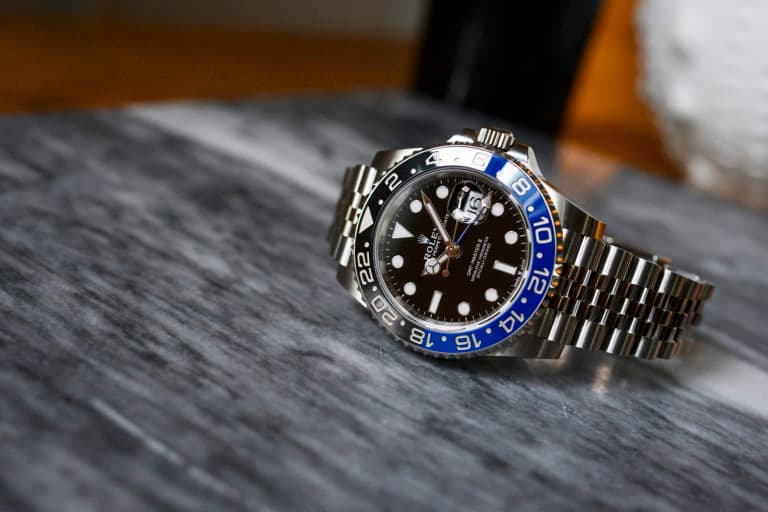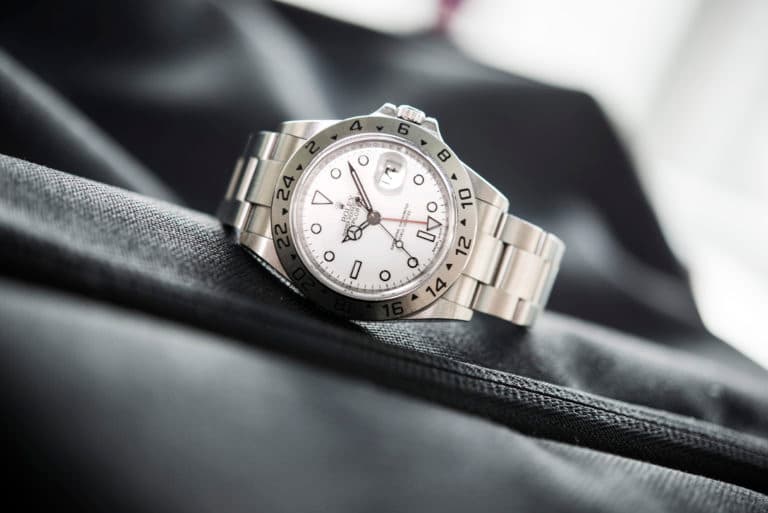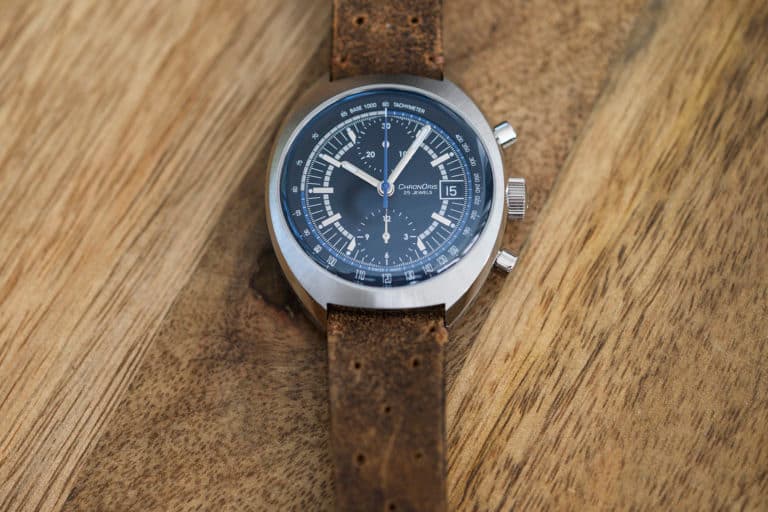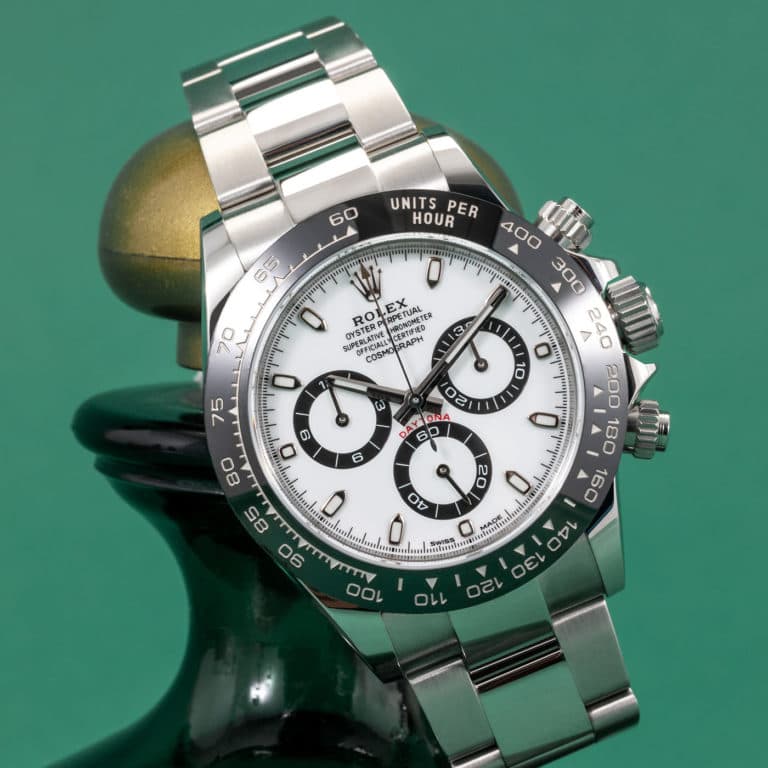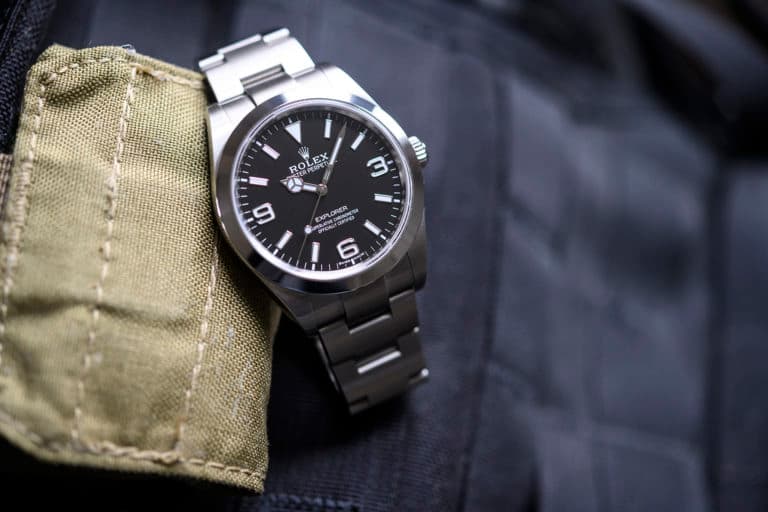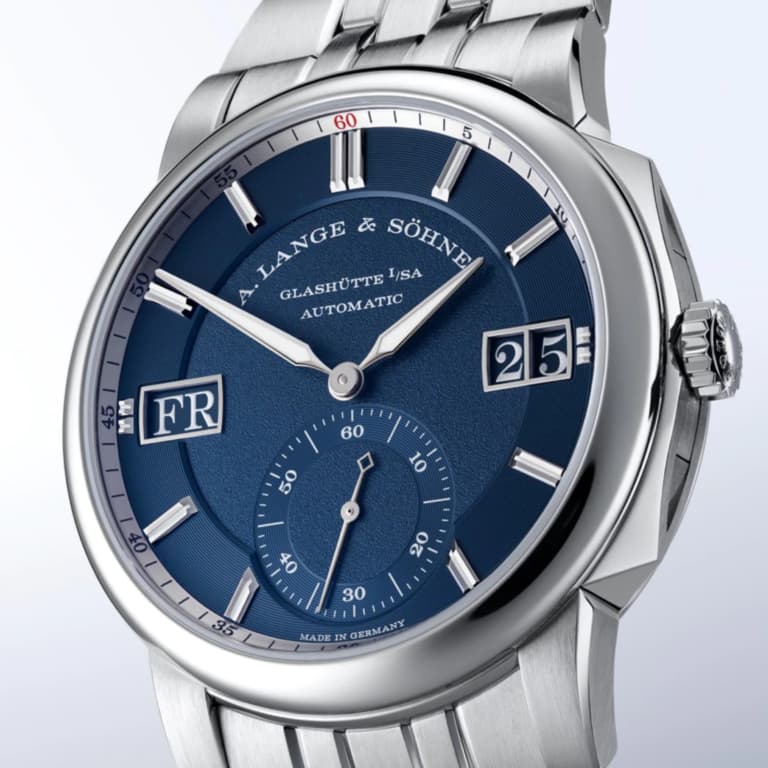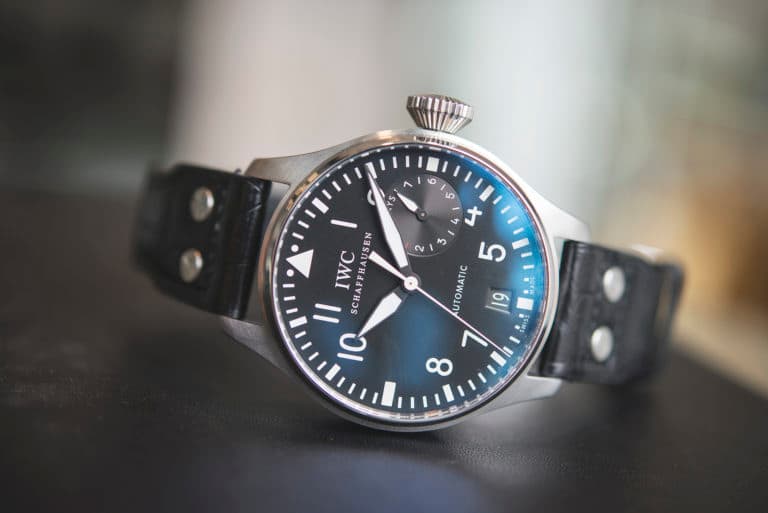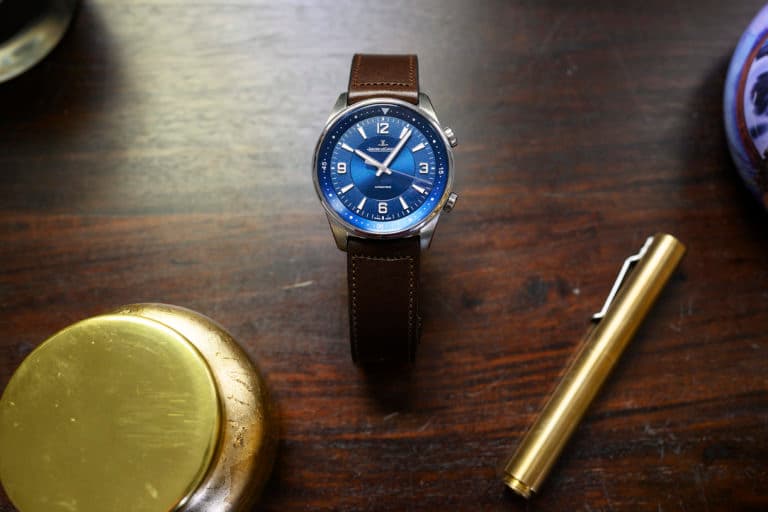The Royal Oak Chronograph is a relative newcomer to the Royal Oak family, with its introduction coming in 1998, a full 26 years after the time-only A-series made its debut in 1972. We’ve discussed the modern Royal Oak and the history that preceded it at length, and while the Chronograph largely sticks to that script, it occupies unique territory within the AP brand, and presents a story all its own. To see how it holds up, we spent some time with the Royal Oak Chronograph (ROC) reference 26331 with a lovely blue dial.

Let’s start with some context. The Royal Oak family of watches have experienced a renaissance in recent years, playing a prominent role in the steel sport watch craze and serving as the backbone of an expanding Audemars Piguet brand. The famous Gerald Genta design has proven adept at accepting evolutionary changes, from new metals, case sizes and even complications. The result has become something of a cultural icon, appearing on screens and in song lyrics, making for long wait lists on some models and skyrocketing resale prices.
For their part, Audemars Piguet has attempted to pivot into new territory, most notably with the newly launched Code 11:59 family of watches. To date, public reception has remained chilly toward such efforts, to put it charitably, leaving the Royal Oak and Royal Oak Offshore collections to shoulder much of the brand’s relevancy. These two collections, while loosely familiar, generally appeal to decidedly different buyers. The Royal Oak Chronograph bridges that gap, walking the line between tradition and progression, representing the give and take nature of the Royal Oak design language.
The First Royal Oak Chronograph
In the early ‘90s Audemars Piguet expanded the Royal Oak family to include a chronograph, and in doing so birthed the Offshore line. The task of designing the watch fell to Emmanuel Gueit at the direction of CEO Stephen Urquhart (who would later go on to helm Omega), looking to capture interest from a younger audience for the Royal Oak family. The resulting watch, released in 1993, would become the Royal Oak Offshore, a robust and sporty take on the otherwise delicate Royal Oak design.

The original Royal Oak Offshore, image credit: Phillips
The Offshore, or ROO as it’s known, served its intended purpose and remains a staple of the AP brand to this day, spawning dozens of variants in all manner of material and complication. For all its success, it’s never really been the Royal Oak chronograph many collectors wanted, it wasn’t an honest take on the complication done in the spirit of the Royal Oak.
In 1998, Audemars Piguet finally released a true Royal Oak Chronograph in the reference 25860. The very first ROC retained a small footprint within a 39mm case and an uncompromised Royal Oak case that was a mere 11mm thick thanks to the F. Piguet 1185 based caliber 2385 inside. The watch has seen relatively few changes since it was introduced the biggest of which was moving from that 39mm case, to a 41mm case (and then to a 38mm case). The reference being reviewed here even holds the same caliber 2385 you’d find in the original from 1998.

AP Cal 2385 // F. Piguet cal 1185
Today, Audemars Piguet offers no less than 11 different variants of the ROC in 41mm alongside the newly introduced 38mm ROC, the reference 26315. Those models are just beginning to hit the market, and we hope to go hands on with one soon so keep an eye out for that. Until then, we’re all about this ROC reference 26331 with blue ‘Grand Tapisserie’ dial.
The Royal Oak Chronograph 26331
On to the watch at hand. The ROC 26331 is a substantial watch. Not in a way that’s overbearing on the wrist, or that’s fussy in use. It’s substantial visually, packing loads of small details into a well proportioned whole. Every bit of this watch is offers visual interest, from the clasp to the dial, no part of this watch feels like it was stamped out of a machine (even if some were). Let’s unpack all of it.

The first thing you might notice about this, and any other Royal Oak, is the bracelet. It is at once stiff, yet flexible exactly where it needs to be around your wrist. Off the wrist, you can set this watch on a table and it’ll stand on its own. Looking at it, or even holding it in your hand you’d think “there’s no way that’s comfortable” – but then you put it on, and somehow, it is. In our review of the 15400 we describe its feeling as somewhere between a jubilee and an oyster bracelet, and it stands true with the ROC as well. How do they do it?
The original bracelet was designed and constructed by prolific Gay Freres (who has since been acquired by Rolex), and that design remains to this day. It is an impressive technical element of the watch that boasts an incredible level of fit and finish. No two links are the same size, and each features a brushed finish with a slight polished bevel at their edges. It is visually dense, catching a lot of light, but at the same time not as flashy as the polished center links you see on Rolex oyster bracelets.

The case is integrated with the bracelet (no NATOs allowed, sorry), with the lugs making a bent at a straight 45 degree (ish?) angle. When viewed top down, the case of the ROC is completely flat, the crystal and the bottom of the case run parallel from edge to edge. For this reason, people generally say you have to have the wrist for the Royal Oak, as the watch isn’t making any concessions to fit you. In reality, it’s far less dramatic, and we’d say most wrist sizes won’t run into too many issues here.

From the dial side, the iconic octagonal shape holds, with the rounded off bezel affixed by 8 bolts fashioned to look like screws. The inspiration for designer Gerald Genta being a porthole as you’d find affixed to early diving helmets. It’s a unique look, and the watch is identifiable from across a crowded room (for better or worse) as a result. The case is also very well constructed and finished, with brushed flat surfaces, and restrained polishing at the edges of both the lugs and the bezel. Even the crown and push guards are brushed for uniformity.
The dial itself features the brands famous Grande Tapisserie pattern, finished in blue in this case, beset with rhodium colored sub dials to serving the chronograph complications. The contrast is striking and the color refreshing and vibrant. The color shifts depending on the light, ranging from light blue-grey to deep navy. The hour markers are white gold batons filled with lume at their center, themselves a reflection of the hands.

Just what is a Grande Tapisserie pattern? A closer look reveals what looks like the surface of a waffle pressed into the dial, but it’s not pressed. It is complex and rich in texture, allowing for those different colors to come through in differing light. The pattern is made via pantograph, yes you read that correctly. Where other textures are created with lasers or casts these days, AP has elected to keep old school.

Inside the ROC beats the caliber 2385, which is based on the Frédéric Piguet caliber 1185. This is a time proven movement that’s been in use since the ‘80s, and still serves within watches like the Vacheron Constantin Overseas Chronograph, and the Blancpain Marine Chronograph. F. Piguet now falls under the SWATCH Group umbrella, serving their high end brands, with brands like AP and VC serving as outside clients. There is certainly nothing wrong with the movement, it presents well and measures a hair over 5mm in thickness, giving manufacturers leeway in creating low profile cases to house it. The ROC is no exception, measuring in at 11mm in overall thickness.
On The Wrist
The above adds up to a rather impressive presence on the wrist, and one that isn’t likely to go unnoticed. The case, the bracelet, the dial… it all just works on the wrist, and the package feels right at home in the 41mm case. About that measurement, it includes the bump out that accommodates the crown, taken from the bezel, it’s a bit smaller, and it shows. The lug to lug measurement is 50mm, but it’s pretty much all case up to the edge, as there isn’t much in the way of lugs. The odd shape of the case and bracelet integration make this a difficult watch to judge against other watches, but wearers will find it comfortable after a brief wear in period.

Using the watch is easier than expected, with strong visibility and faux screw-in pushers. In reality they are simple press and go, unlike older references which required unscrewing of the push protectors. There are just two small niggles that may interfere with the pure bliss otherwise presented by the dial.

The first is that date window. It’s color matched to the dial, which is fantastic, but the placement of the aperture is closer to the 5 o’clock baton than the 4 o’clock baton, and the slightly off-centered nature of it will undoubtedly trigger the OCD of some wearers. It is centered between the two sub dials on the 3 o’clock side of the dial, but it’s something that, once noticed, will not go unnoticed.

The second issue is the timing seconds hand. There’s nothing inherently offensive about it, but the tail hanging off the end not in use is unusually long. Because of this, and the fact that it’s the same design as the hour and minute hand, means it can, at times, interfere with your eyes’ ability to discern the time at a glance. Even more so when the chronograph is in use, appearing as a 4th, small hand at times. Not a deal breaker, but something potential buyers should be aware of.

Lastly, and this isn’t an issue with the dial, the crown can be fussy to unscrew, manipulate, and screw back into place. The crown fits within a tight tolerance between the guards, and there isn’t much forgiveness if you aren’t dead center when screwing back into place.
Competition
The Royal Oak Chronograph ref 26331 in steel has a retail price of $24,300, but on the resale market, trades for closer to $28,000. No small sum, but even so it’s up against some interesting sport chronographs in this price range.
Yes, we hear you pointing out that the retail price of a steel Daytona is more than $10k south of the ROC, but unless you have a very cozy relationship with your local AD, you’re paying somewhere between $22k and $24k for your Daytona, putting it squarely in the range of the ROC. Of course, Audemars Piguet is a more prestigious manufacture than Rolex, and the Royal Oak clearly features a level of finishing and detail that set it apart from the Daytona. But, the Daytona is also a fantastic watch, which holds a true Rolex manufactured movement, and it has a far more interesting history built in. Add on the hype factor we’re experiencing today and you’ve got a worthy ROC contender on your hands.
Vacheron Constantin Overseas Chronograph
The Overseas Chronograph from Vacheron Constantin uses the same movement you’ll find in the ROC, and the manufacture sits on a level playing field to that of Audemar Piguet. It’s a good match up, and it even comes with a blue dial, should you choose. However, the Overseas Chronograph with blue dial and bracelet, in steel, retails for $27,800, and doesn’t feature the level detail you’ll find in the ROC. On top of that, resale value for the VC is far weaker than AP or Rolex, if that type of thing concerns you. This is a fantastic watch, but probably overpriced by $5k to be a reasonable consideration. Thankfully, you can find this watch on StockX for far less than retail.
Bulgari Octo Finissimo Chronograph GMT Automatic
The latest from Bulgari, the Octo Finissimo Chronograph offers some serious competition to the ROC. It is, as we’ve highlighted before, the world’s thinnest automatic chronograph, and is housed in a case not entirely dissimilar to the ROC, being flat and angular. Additionally, its retail price is a very reasonable $17,600, if you can find one, that is.
Conclusion
Audemars Piguet has done a fantastic job with the Royal Oak Chronograph in each generation. It’s clearly a revered name and AP does it justice with the level of detail and execution they bring to the Chronograph. It’s hard to think of a watch in this price range that offers as much as the ROC and gets everything right. AP manages to do just that here, with brilliant color, flawless construction, and a genuinely unique design language that stands apart in a sea of similarity.

The ROC is a beautiful watch, and worth the price of admission by any standard. The 41mm case should be welcomed alongside the 38mm option for its wearability and its ability to stand clear apart from the Offshore family while closing the gap that separates them.








